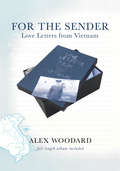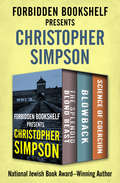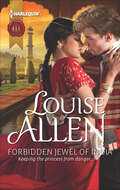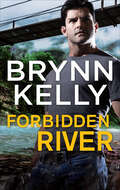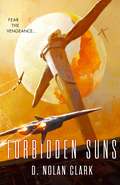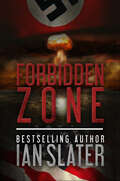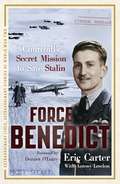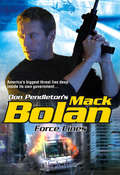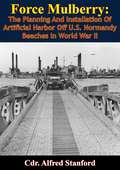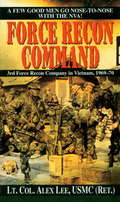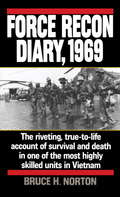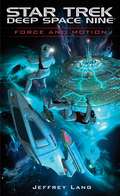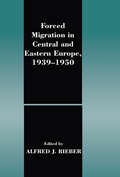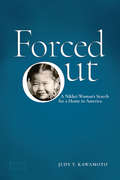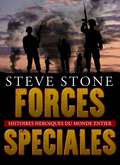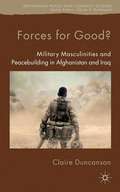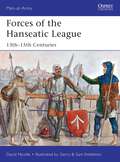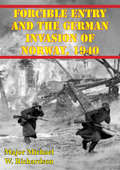- Table View
- List View
For the Sender: Love Letters From Vietnam
by Alex WoodardDear Sergeant Fuller,You won't know me for another two years,but I am your daughter....So begins a letter sent decades into the past, from a daughter searching for answers to a soldier serving in war-torn Vietnam, in this true story of service and sacrifice, love and redemption, and the power of forgiveness.A box with Love Letters from Vietnam etched on the lid waits buried in a closet, holding scrawled thoughts written on Air Force stationery from a passionate yet deeply flawed soldier stationed outside Da Nang to his young wife in east Texas. Years pass before a fateful, deadly winter night leads the soldier's daughter, Jennifer, to open the box, read the letters, and answer her father back in time. She tucks her letters into a package with no address, because she no longer knows where to send them.Until she is sitting in a theater in Austin, Texas, at a performance by singer-songwriter Alex Woodard and hears him talk about writing songs inspired by letters. Her remarkable correspondence with her father takes Woodard on his first steps into the dichotomy between dark and light, as he imagines himself as Sergeant Fuller in Vietnam and begins to write songs sung from Fuller's heart.Woodard's quest to learn more about the man and the war he fights both in Vietnam and back at home evolves into an extraordinary journey, propelled by an album included with the book that features Woodard as Sergeant Fuller and his friend Molly Jenson as Jennifer. Their voices carry the songs inspired by these beautiful, raw, revealing love letters not only sent from Vietnam, but as the story unfolds, beyond.
Forbidden Bookshelf Presents Christopher Simpson: The Splendid Blond Beast, Blowback, and Science of Coercion (Forbidden Bookshelf)
by Christopher SimpsonThree provocative exposés from a National Jewish Book Award–winning journalist address the CIA&’s recruitment of Nazis and use of psychological warfare. The Splendid Blond Beast: This groundbreaking investigation into the CIA&’s post–World War II liberation and recruitment of Nazi war criminals—including the pivotal role played by CIA director Allen Dulles—traces the roots not only of US government malfeasance, but of mass murder as an instrument of financial gain and state power, from the Armenian genocide during World War I to Hitler&’s Holocaust through the practice of genocide today. &“Revelatory and shocking.&” —Kirkus Reviews Blowback: The true story of how US intelligence organizations employed Nazi war criminals in clandestine warfare and propaganda against the USSR, anticolonial revolutionaries, and progressive movements worldwide that were claimed to be Soviet pawns. &“The story is one that needs to be told, and Blowback makes a major contribution to its telling, supplementing a thorough collation of known cases with ample new research.&” —The New York Times Science of Coercion: Drawing on long-classified documents from the Pentagon, the CIA, and other national security agencies, Simpson exposes secret government-funded research into psychological warfare and reveals that many of the most respected pioneers in the field of communication science were knowingly complicit as their findings were employed for the purposes of propaganda, subversion, intimidation, and counterinsurgency during the Cold War era. &“An intriguing picture of the relations between state power and the intellectual community.&” —Noam Chomsky, Massachusetts Institute of Technology
Forbidden Jewel of India (The Herriard Family)
by Louise AllenAnusha Laurens is in danger. The daughter of an Indian princess and an English peer, she's the perfect pawn in the opulent courts of Rajasthan. Even so, she will not return to the father who rejected her.Arrogant angrezi Major Nicholas Herriard is charged with bringing the alluring princess safely to her new life in Calcutta. Nick's mission is to protect, to serve-but under the searing Indian sun an initial attraction unfurls into a forbidden temptation.This beautiful, impossible princess tests the very limits of his honor-especially when Nick is left with only one option to keep Anusha safe: marriage. But the fast-flowing waters of the Ganges determine a different fate, and duty may separate them forever....
Forbidden Lover (Gallagher Justice)
by Amanda StevensGet ready for a new brand of justice... Born to a legacy of lawman, three brothers sworn to serve and protect will safeguard the women they love.GALLAGHER JUSTICEThe feud between the Gallaghers and the O'Roarkes had raged for generations. And Detective Nick Gallagher would do whatever it took to keep his father's killer-a hated O'Roarke-in prison. Even commandeer the assistance of the beautiful Dr. Erin Casey-with or without her consent!Erin had almost forgotten her secret past-until Nick's demands put her in the spotlight. When threats forced her into Nick's protection, Erin knew time was running out. Even as his hard body and sky-blue eyes awoke her deepest passions, Erin tried to resist Nick's talk of the future. Because Nick would soon know he was falling for the daughter of his bitterest enemy...
Forbidden Night with the Highlander: Married To Claim The Rancher's Heir Forbidden Night With The Highlander Redeeming The Roguish Rake (Warriors of the Night #2)
by Michelle WillinghamThe handsome Highlander who seduced her……is the very man she must marry!In this Warriors of the Night story, Lianna MacKinnon seeks to avoid her betrothal to a Norman lord by giving herself to an intriguing stranger. But afterward, she discovers her sensual lover is none other than Rhys de Laurent—her betrothed—in disguise! They’ve already had their wedding night… Now there’s no escaping their marriage vows!Warriors of the Night miniseriesBook 1 — Forbidden Night with the WarriorBook 2 — Forbidden Night with the Highlander Book 3 — Forbidden Night with the Prince — coming soon“Willingham has written another winner!”— RT Book Reviews on Warrior of Fire “Medieval fans are in for a treat, as this novel has everything — star-crossed lovers, scandal, murder, damsels in distress, dark, sexy heroes, lots of action, battles and a hard-won happy ending!” — RT Book Reviews on Forbidden Night with the Warrior
Forbidden Places
by Penny VincenziPenny Vincenzi's Sunday Times No 1 bestseller, FORBIDDEN PLACES is an unmissable novel about love and marriage, families and secrets, and about wartime and what it does to every accepted social value. 'Deliciously readable' Mail on Sunday. A mesmerising novel perfect for any reader of Jilly Cooper, Santa Montefiore, Kate Morton or Harriet Evans.It is the story of three women and one family. One is married and widowed within five years. She is free to start again. Or is she? The second has a perfect husband she thinks she loves. He becomes a grotesque parody of what he once was. Is that love real? The third becomes trapped in a nightmare marriage. Can the war free her?
Forbidden Places
by Penny VincenziPenny Vincenzi's Sunday Times No 1 bestseller, FORBIDDEN PLACES is an unmissable novel about love and marriage, families and secrets, and about wartime and what it does to every accepted social value. 'Deliciously readable' Mail on Sunday. A mesmerising novel perfect for any reader of Jilly Cooper, Santa Montefiore, Kate Morton or Harriet Evans.It is the story of three women and one family. One is married and widowed within five years. She is free to start again. Or is she? The second has a perfect husband she thinks she loves. He becomes a grotesque parody of what he once was. Is that love real? The third becomes trapped in a nightmare marriage. Can the war free her?
Forbidden Places: A Novel
by Penny Vincenzi“Vincenzi does an admirable job of evoking the bustle and fears of wartime England . . . plenty of juicy plot twists and turns to keep readers hooked.” —Booklist In the English countryside during World War II, Grace settles into a new life with her wealthy husband, but struggles to get along with her sister-in-law, Florence. When she discovers a scandalous secret, her dislike of Florence seems justified. Yet there are things she doesn’t fully understand. And she is puzzled—and frustrated—to learn that Florence’s friend, the stylish, sexy Clarissa, has a past with her husband that is shrouded in mystery, in this “engrossing family drama” from the beloved bestselling author (Glamour).“With her well-drawn characters and engaging style, Vincenzi keeps things humming.” —People“Vincenzi writes . . . fast-paced novels with plots and subplots so deftly manipulated that it’s impossible to start reading one and still lead a productive life.” —The Washington Post
Forbidden River (The Legionnaires)
by Brynn KellyA dangerous game at the end of the earth…For French Foreign Legionnaire Cody Castillo, chasing deadly thrills is the only reprieve from a bloodstained past he can’t forget. But when the adrenaline junkie finds himself caught in a mass murderer’s crosshairs in the lonely wilds of New Zealand, he finds an unexpected—and intriguing—ally.Former air force pilot Tia Kupa has always found safety in nature, until a killer turns the wilderness into a playground. In this life-or-death game, the guarded woman who lives by the rules must rely on a risk taker with a death wish. The sexy devil-may-care legionnaire may be the wrong guy for her, but desire is just as primal as terror. Even if they outrun a predator, they can’t escape the sizzling bond neither of them saw coming.
Forbidden Suns (The Silence #3)
by D. Nolan ClarkThe third and final book in the epic space adventure trilogy by D. Nolan Clark.In the cold of space, the fire of revenge still burns. Aleister Lanoe has been on a mission since before he can remember. Honing his skills as a fighter pilot and commander through three centuries of constant warfare, he has never met a foe he cannot best. But now he faces a mission which may be his last: take vengeance on the alien race who has coldly and systematically erased all the sentient life in its path. In all his years at war, the stakes have never been higher...The Silence TrilogyForsaken SkiesForgotten WorldsForbidden Suns
Forbidden Zone
by Ian SlaterThe Nazis&’ dark secrets are revealed, in a tense and compelling thriller from bestselling author Ian Slater.June 1944. The moment has come. The Allied pincers are closing in. Hitler has already ordered his jet fighters, V-1 flying bombs, and V-2 rockets into action. Now, in a desperate bid to keep his war machine churning, it is time for the führer to use the most secret weapon of all.For G.I. David Adam, it's a mission into hell. To stop Hitler&’s mad plan will take him and others into the lion&’s den, under the shadow of the SS—where exposure means death, but being killed is better than being taken alive…Only a handful of courageous men and women can stop Hitler&’s terrifying superweapon, and helped by French resistance fighters, Jewish slave laborers, and members of the Polish underground, these few will fight the most critical battle of the entire war.
Force Benedict
by Eric Carter Anthony LovelessSecond World War fighter pilot Eric Carter is one of only four surviving members of a secret mission, code-named 'Force Benedict'. Sanctioned by Winston Churchill in 1941, Force Benedict was dispatched to defend Murmansk, the USSR's only port not under Nazi occupation. If Murmansk fell, Soviet resistance against the Nazis would be hard to sustain and Hitler would be able to turn all his forces on Britain... Force Benedict was under the command of New Zealand-born RAF Wing Commander Henry Neville Gynes Ramsbottom-Isherwood, who led two squadrons of Hurricane fighters, pilots and ground crew which were shipped to Russia in total secrecy on the first ever Arctic Convoy. They were told to defend Murmansk against the Germans 'At all costs'. 'We all reckoned the government thought we'd never survive' - but Eric Carter did, and was threatened with Court Martial if he talked about where he'd been or what he'd done. Now he reveals his experiences of seventy years ago in the hell on earth that was Murmansk, the largest city north of the Arctic Circle. It will also include previously unseen photos and documents, as well as exploring - for the first time - other intriguing aspects of Force Benedict.
Force Benedict (Extraordinary Lives, Extraordinary Stories of World War Two #2)
by Eric Carter Anthony LovelessSecond World War fighter pilot Eric Carter is one of only four surviving members of a secret mission, code-named 'Force Benedict'. Sanctioned by Winston Churchill in 1941 Force Benedict was dispatched to defend Murmansk, the USSR's only port not under Nazi occupation. If Murmansk fell, Soviet resistance against the Nazis would be hard to sustain and Hitler would be able to turn all his forces on Britain...Force Benedict was under the command of New Zealand-born RAF Wing Commander Henry Neville Gynes Ramsbottom-Isherwood, who led two squadrons of Hurricane fighters, pilots and ground crew which were shipped to Russia in total secrecy on the first ever Arctic Convoy. They were told to defend Murmansk against the Germans 'at all costs'. 'We all reckoned the government thought we'd never survive' - but Eric Carter did, and was threatened with Court Martial if he talked about where he'd been or what he'd done. Now he reveals his experiences of seventy years ago in the hell on earth that was Murmansk, the largest city north of the Arctic Circle. It will also include previously unseen photos and documents, as well as exploring - for the first time - other intriguing aspects of Force Benedict.
Force Lines (SuperBolan #112)
by Don PendletonBLACK HORIZON. The most dangerous enemies are the unseen, and Mack Bolan's instincts are kicking in, alerting him to a horrific conspiracy so deep within the U.S. government that invisible spooks with unlimited power will never be held accountable for the atrocities they unleash. One conspiracy wrapped in another: an Armageddon group called Sons of Revelation, a man-made plague set to be released in south Florida, and rumors of terror imports from the home team. It's treason, betrayal of the highest order, an act of savagery that will not go unchallenged-at whatever price Bolan may have to pay. Judgment Day is now, for patriots willing to sell out their nation for greed and twisted ambition.
Force Mulberry: The Planning And Installation Of Artificial Harbor Off U.S. Normandy Beaches In World War II [Illustrated Edition]
by Cdr. Alfred Stanford Rear Admiral Samuel E. MorisonThis edition contains numerous illustrations and maps."In this book Commander Stanford has made a very important contribution to the history of World War II, and in the writing of it he has recaptured the tense excitement, almost desperation, of planning and executing the landings in Normandy. The "Mulberries," the two artificial harbors established immediately after the initial landings, were absolutely essential for the success of Operation Overlord. For, as we found out in World War II, the most difficult thing in an amphibious operation is not to establish the initial beachhead--that can almost always be done if sufficient force is employed and tactical surprise is obtained--but to sustain and reinforce the ground troops against the beachhead, and attain the objective."Massive as was the Anglo-American assault on the Normandy beaches, it had to be followed up immediately by even greater increments of men, armor, vehicles and supplies to make it succeed. There was no possibility of getting all this ashore over wave-lashed beaches where spring tides rose twenty-one feet. One or more ports were essential to maintain an even flow of men and matériel. But all the French ports, notably the nearest ones at Cherbourg and Le Havre, were so strongly held by the enemy that the capture of one would employ forces badly needed elsewhere for at least six weeks, during which the Germans would be unexpectedly weak or very stupid if they did not succeed in rubbing out the initial beachhead."The only possible way out of this dilemma was the apparently impossible task of providing sheltered water off the beaches within a matter of three days. Since speed was of the essence, all elements of the artificial harbors would have to be constructed in England, towed across the Channel under danger of wind, weather and enemy air attack, and sited under fire..."--Rear Admiral Samuel E. Morison
Force Recon Command
by Alex LeeTHE A SHAU VALLEYWHERE THE NVA WAS KING . . . In order to prevent surprise attacks on U.S. forces as they were pulling out of Vietnam, someone had to be able to pinpoint the NVA's movements. That dangerous job was the assignment of then-major Alex Lee and the Marines of the 3rd Force Reconnaissance Company when he assumed command in late 1969. They became the tip of the spear for Lt. Gen. Herman Nickerson's III MAF. And each time one of Lee's small, well-motivated, well-led, and wildly outnumbered teams was airlifted into the field, the men never knew if the day would end violently.But whether tracking NVA movements, recovering downed air crews, or making bomb-damage assessments after B-52 strikes, Major Lee's Few Good Men never forgot who they were: Each of them was in Vietnam to live like a Marine, win like a Marine, and, if need be, die like a Marine.Forthright and unabashed, Lieutenant Colonel Lee leaves no controversy untouched and no awe-inspiring tale untold in this gripping account of 3rd Force Recon's self-sacrifice and heroic achievement in the face of overwhelming odds.From the Paperback edition.
Force Recon Diary, 1969
by Major Bruce H. NortonThe riveting, true-to-life account of survival, heroism and death in the elite Marine 3d Force Recon unit, one of one two Marine units to receive the Valorous Unit Citation during the Vietnam War. Doc Norton, leader of 3d Force Recon, recounts his team's experiences behind enemy lines during the tense patrols, sudden ambushes and acts of supreme sacrifice that occurred as they gathered valuable information about NVA operations right from the source.
Force and Motion (Star Trek)
by Jeffrey LangA thrilling original novel set in the universe of Star Trek: The Next Generation / Deep Space Nine!In 2367, Captain Benjamin Maxwell of the starship Phoenix ordered the destruction of a Cardassian warship and a supply vessel, killing more than six hundred crew members. Maxwell believed that the Cardassians were arming for a new attack on the Federation, and though history eventually proved he was probably correct, the Federation had no choice but to court martial and incarcerate him. Almost twenty years have passed, and now Maxwell is a free man, working as a maintenance engineer on the private science station Robert Hooke, home to crackpots, fringe researchers, and, possibly, something much darker and deadlier. Maxwell's former crewmate, Chief Miles O'Brien, and O'Brien's colleague, Lieutenant Commander Nog, have come for a visit. Unfortunately, history has proven that whenever O'Brien and Nog leave Deep Space 9 together, unpredictable forces are set into motion... TM, ®, & © 2016 CBS Studios, Inc. STAR TREK and related marks are trademarks of CBS Studios, Inc. All Rights Reserved.
Forced Migration in Central and Eastern Europe, 1939-1950
by Alfred J. RieberThese nine case studies, written by Russian, German and Austrian scholars and based on archival findings, should shed new light on deportations and resettlement in Poland, Hungary, Czechoslovakia and Germany. The introduction places forced migration throughout the region in a historical context.
Forced Out: A Nikkei Woman’s Search for a Home in America (Nikkei in the Americas)
by Judy Y. KawamotoForced Out: A Nikkei Woman’s Search for a Home in America offers insight into “voluntary evacuation,” a little-known Japanese American experience during World War II, and the lasting effects of cultural trauma. Of the roughly 120,000 people forced from their homes by Executive Order 9066, around 5,000 were able to escape incarceration beforehand by fleeing inland. In a series of beautifully written essays, Judy Kawamoto recounts her family’s flight from their home in Washington to Wyoming, their later moves to Montana and Colorado, and the influence of those experiences on the rest of her life. Hers is a story shared by the many families who lost everything and had to start over in often suspicious and hostile environments. Kawamoto vividly illustrates the details of her family’s daily life, the discrimination and financial hardship they experienced, and the isolation that came from experiencing the horrors of the 1940s very differently than many other Japanese Americans. Chapters address her personal and often unconscious reactions to her parents’ trauma, as well as her own subsequent travels around much of the world, exploring, learning, enjoying, but also unconsciously acting out a continual search for a home. Showing how the impacts of traumatic events are collective and generational, Kawamoto draws interconnections between her family’s displacement and later aspects of her life and juxtaposes the impact of her early experiences and questions of identity, culture, and assimilation. Forced Out will be of great interest to the general reader as well as students and scholars of ethnic studies, Asian American studies, history, education, and mental health.
Forced to Change: Crisis and Reform in the Canadian Armed Forces
by Colonel Bernd Horn Dr Bill Bentley Lieutenant-General Ret DallaireUndeniably, the 1990s were a period of crisis for the Canadian Armed Forces (CAF). Drastic budget reductions and a series of endless scandals all collided to form the perfect storm. The outcome of this was nothing short of the implosion of the Canadian Armed Forces Officer Corps. Stripped by the government of the right to regulate itself, the Officer Corps, which represented the nation’s stewards of the profession of arms, was forced to reform itself. Key to this transformation was education. However, the road was not easy, as cultural change rarely is. Forced to Change tells the story of how the Canadian Armed Forces found itself at its lowest point in history and how it managed to reform itself. The question is whether it was a fundamental transformation or just a temporary adjustment to weather the storm.
Forces Speciales : Histories Heroiques Du Monde Entier
by Steve StoneLes forces spéciales sont des unités militaires formées pour accomplir des missions non conventionnelles. Elles sont apparues au début du XXe siècle et ont connu un essor important au cours de la Seconde Guerre mondiale, avec la création de forces spéciales telles que les SAS et les U.S. Navy SEALs. Cette sélection d'histoires captivantes sur les forces spéciales du monde entier. Couvrant quatre décennies d'opérations extraordinaires, cette sélection de récits captivants des forces spéciales du monde entier. On y trouve notamment les opérations Eagle Claw, Gothic Serpent et Neptune Spear, ainsi que de nombreuses autres histoires pleines d'action. Les forces spéciales sont très respectées et les soldats qui font partie de ces unités d'élite ont subi une sélection et un entraînement difficiles pour arriver en première ligne. Qu'il s'agisse d'un opérateur de la Delta Force, d'un Navy SEAL, d'un soldat du SAS ou de tout autre opérateur des forces spéciales. Aujourd'hui, une étroite collaboration est la clé de nombreuses missions, même si la rivalité existe pour être le meilleur, le premier à atteindre un objectif ou à s'attaquer à une cible de premier plan. Les histoires de ce livre ont été choisies pour montrer non seulement les succès, mais aussi les échecs et les leçons tirées de chaque opération. La haute technologie ne remplace toujours pas les bottes sur le terrain, où des agents hautement qualifiés peuvent encore recueillir des renseignements qu'aucun œil dans le ciel n'est capable d'obtenir.
Forces for Good?
by Claire DuncansonThis book utilises the growing phenomenon of British soldier narratives from Iraq and Afghanistan to explore how British soldiers make sense of their role on these complex, multi-dimensional operations. It aims to intervene in the debates within critical feminist scholarship over whether soldiers can ever be agents of peace.
Forces of the Hanseatic League
by David Nicolle Gerry EmbletonThe famous but largely unchronicled Hanseatic League (or simple "the Hanse/Hansa") was a Tuetonic German commercial and defensive federation of merchant guilds based in harbor towns along the North Sea and Baltic coasts of what are now Germany and her neighbors, which eventually dominated maritime trade in Northern Europe and spread its influence much further afield. The League was formed to protect the economic and political interests of member cities throughout a vast and complex trading network. While most members remained basically subject to the local rulers who profited from their prosperity, in a sense the League might be seen as foreshadowing today's ambiguous relationship between global corporations and political nation states.The League continued to operate well into the 17th century, but its golden age was between c. 1200 and c. 1500; thereafter it failed to take full advantage of the wave of maritime exploration to the west, south and east of Europe. During its 300 years of dominance the League's large ships - called "cogs" - were at the forefront of maritime technology, were early users of cannon, and were manned by strong fighting crews to defend them from pirates in both open-sea and river warfare. The home cities raised their own armies for mutual defence, and their riches both allowed them, and required them, to invest in fortifications and gunpowder weapons, since as very attractive targets they were subjected to sieges at various times.
Forcible Entry And The German Invasion Of Norway, 1940
by Major Michael W. RichardsonThe air-sea-land forcible entry of Norway in 1940 utilized German operational innovation and boldness to secure victory. The Germans clearly met, and understood, the conditions that were necessary to achieve victory. The central research question of this thesis is: What lessons concerning setting the conditions for present day forcible entry operations can be gleaned from the successful German invasion of Norway in 1940? Forcible entry is the introduction of an aggregation of military personnel, weapons systems, vehicles, and necessary support, or a combination thereof, embarked for the purpose of gaining access through land, air, or amphibious operations into an objective area against resistance. This aggregation of military force attempts to set conditions that cripple the enemy's ability to react decisively to, or interfere with, the forcible entry operation. The German emphasis on surprise and speed, an effective psychological campaign, and combined operations under a unified command in the invasion of Norway rendered the Norwegian and Allied intervention forces (including the Royal Navy which dominated the seas in the area) incapable of seriously interfering with the German forcible entry.
